Fannie Ward, a.k.a. Fanny Ward (1871–1952) was a star of light comedies on Broadway and in vaudeville. Internationally famous, she was at the height of her career in the first decade of the 20th century. Later she was known for The Cheat (1915), a sexually- and racially-charged silent film directed by Cecil B. DeMille. In the late 1910s, she did a series of films for Astra Films, released by Pathé Exchange.

British postcard. Fannie Ward in The Cheat (Cecil B. DeMille, 1915).

British postcard in the Pictures Portrait Gallery by Pictures Ltd, London, no. 98.

British postcard in the Cinema Chat series. Photo: Evans / Pathé.
Fannie Ward was born Fannie Buchanan in St. Louis, Missouri, in 1871 or 1872, the sources differ. Ward was the only daughter of Eliza and John Buchanan, who was a dry goods merchant. She had a brother, Benton.
In 1890, against the wishes of her parents, Ward made her stage debut as Cupid in 'Pippino' with vaudevillian star Eddie Foy. She soon became a success in 10 stage productions in New York City before sailing in 1894 to London, where she performed in 'The Shop Girl'.
Her performances led critics to compare Ward favourably to actress Maude Adams. In 1898, however, she married wealthy diamond merchant Joe Lewis and retired from the stage.
Ward resumed her career in 1905 after her husband 'Diamond Joe' suffered severe business losses that left him, according to news reports, "practically penniless".
In 1907, she returned to the Broadway stage to perform in 'A Marriage of Reason' at the Wallack's Theatre. She was then cast two years later in another Broadway production, 'The New Lady Bantock'; and after its run at Wallack's, she and other cast members took the play on tour to various cities during the latter half of 1909.
Yet another popular Broadway play in which she performed was the comedy 'Madam President', which was presented at the Garrick Theatre from September 1913 to January 1914.
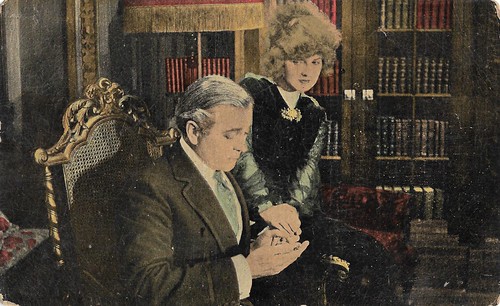
Spanish 'cromo'. Photo: Jesse L. Lasky / Paramount. Fannie Ward and Charles Clary in Each Pearl a Tear (George Melford, 1916).
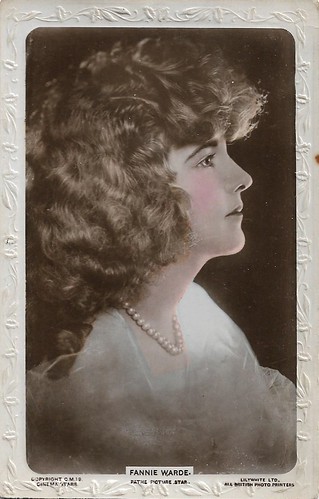
British postcard in the Cinema Stars series by Lilywhite Ltd., no. C.M. 19. Photo: Pathé. Ward's name is misspelled on this card.
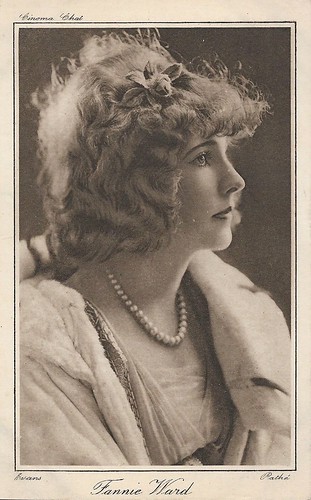
British postcard by Cinema Chat. Photo: Evans / Pathé.
In 1915, around the time Fannie Ward's stage career was waning, American film producer and director Cecil B. DeMille convinced her to perform in The Cheat (1915), a silent film melodrama co-starring Japanese actor Sessue Hayakawa. The film proved to be a sensation due to its plot mingling of racial and sexual themes.
In The Cheat, Ward portrays a society woman who embezzles money and turns to an Asian ivory dealer (Hayakawa) for help, with brutal consequences. The film features a shocking scene in which Ward's character is branded and nearly raped.
Although she was 43 when she made the film, she appeared much younger (she claimed she was 40). The film launched the careers of DeMille and Hayakawa, who soon became Hollywood's first Asian star. It also began a busy film career for Ward for the next few years, at least 15 of her 26 films co-starring her second husband John Dean.
When she and Dean built their huge Italian mansion in 1919, it was a well-publicised event. Known as 'The Youth Girl', she was continually cast in roles that were 20 to 30 years younger than her actual age. After making The Hardest Way (1919 or 1921) with Theodore Roberts, she decided to go back on the vaudeville circuit.
However, Ward also appeared on screen in such shorts as the Phonofilm short Father Time (1924) in which she sings; another Phonofilm production, The Perennial Flapper (1924); and in the Vitaphone short The Miracle Woman (1929).
In 1926, trading on her ever-youthful public image, Ward opened a Paris beauty shop, 'The Fountain of Youth'. She continued touring on vaudeville occasionally into the 1930s, still belying her age, now well into her sixties.
Fannie Ward was married twice. Her first husband was Joseph Lewis, a British money lender and diamond dealer. They married in 1898. In 1913, Ward and Lewis divorced. The following year she married her second husband, John Wooster Dean an actor who frequently co-starred with her on stage and in films. Ward's only child, Dorothé Mabel Lewis (1900–1938), died in a plane crash in 1938. Dorothé was the result of an affair with Viscount Castlereagh, who in 1915 became The Most Hon. the 7th Marquess of Londonderry, an Anglo-Irish aristocrat from Ulster.
Ward lost her husband in 1950. In 1952, at age 79 or 80, Ward suffered a stroke in her Park Avenue apartment and was found unconscious by a neighbour. She remained in a coma until her death six days later at Lenox Hill Hospital. The New York Times reported that Ward died without a will and left an estate with an estimated value of $40,000. The newspaper also reported that she was survived by "three English grandsons": Lord Patrick Plunkett, the Hon. Shaun Plunkett, and the Hon. Robin Plunkett.
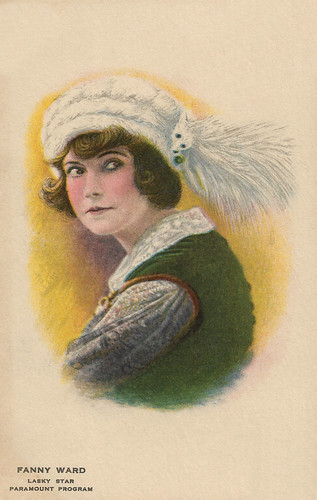
American postcard by Kline Poster Co. Inc., Phila. Illustration: Lasky / Paramount.

French postcard in the Les Vedettes du Cinéma series by Filma, no. 11. Photo: Evans, L.A. / Agence Générale Cinematographique.
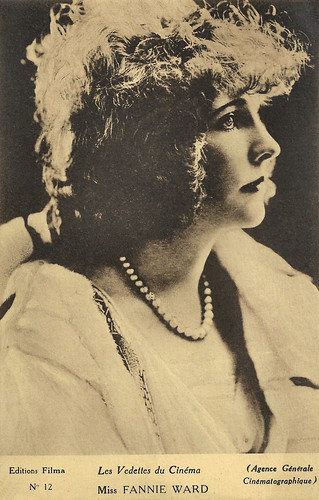
French postcard by Editions Filma in the Les Vedettes du Cinéma series, no. 12. Photo: Agence Générale Cinématographique.
Sources: Silents are Golden, Wikipedia, and IMDb.

British postcard. Fannie Ward in The Cheat (Cecil B. DeMille, 1915).

British postcard in the Pictures Portrait Gallery by Pictures Ltd, London, no. 98.

British postcard in the Cinema Chat series. Photo: Evans / Pathé.
Penniless Diamond Joe
Fannie Ward was born Fannie Buchanan in St. Louis, Missouri, in 1871 or 1872, the sources differ. Ward was the only daughter of Eliza and John Buchanan, who was a dry goods merchant. She had a brother, Benton.
In 1890, against the wishes of her parents, Ward made her stage debut as Cupid in 'Pippino' with vaudevillian star Eddie Foy. She soon became a success in 10 stage productions in New York City before sailing in 1894 to London, where she performed in 'The Shop Girl'.
Her performances led critics to compare Ward favourably to actress Maude Adams. In 1898, however, she married wealthy diamond merchant Joe Lewis and retired from the stage.
Ward resumed her career in 1905 after her husband 'Diamond Joe' suffered severe business losses that left him, according to news reports, "practically penniless".
In 1907, she returned to the Broadway stage to perform in 'A Marriage of Reason' at the Wallack's Theatre. She was then cast two years later in another Broadway production, 'The New Lady Bantock'; and after its run at Wallack's, she and other cast members took the play on tour to various cities during the latter half of 1909.
Yet another popular Broadway play in which she performed was the comedy 'Madam President', which was presented at the Garrick Theatre from September 1913 to January 1914.

Spanish 'cromo'. Photo: Jesse L. Lasky / Paramount. Fannie Ward and Charles Clary in Each Pearl a Tear (George Melford, 1916).

British postcard in the Cinema Stars series by Lilywhite Ltd., no. C.M. 19. Photo: Pathé. Ward's name is misspelled on this card.

British postcard by Cinema Chat. Photo: Evans / Pathé.
The film proved to be a sensation
In 1915, around the time Fannie Ward's stage career was waning, American film producer and director Cecil B. DeMille convinced her to perform in The Cheat (1915), a silent film melodrama co-starring Japanese actor Sessue Hayakawa. The film proved to be a sensation due to its plot mingling of racial and sexual themes.
In The Cheat, Ward portrays a society woman who embezzles money and turns to an Asian ivory dealer (Hayakawa) for help, with brutal consequences. The film features a shocking scene in which Ward's character is branded and nearly raped.
Although she was 43 when she made the film, she appeared much younger (she claimed she was 40). The film launched the careers of DeMille and Hayakawa, who soon became Hollywood's first Asian star. It also began a busy film career for Ward for the next few years, at least 15 of her 26 films co-starring her second husband John Dean.
When she and Dean built their huge Italian mansion in 1919, it was a well-publicised event. Known as 'The Youth Girl', she was continually cast in roles that were 20 to 30 years younger than her actual age. After making The Hardest Way (1919 or 1921) with Theodore Roberts, she decided to go back on the vaudeville circuit.
However, Ward also appeared on screen in such shorts as the Phonofilm short Father Time (1924) in which she sings; another Phonofilm production, The Perennial Flapper (1924); and in the Vitaphone short The Miracle Woman (1929).
In 1926, trading on her ever-youthful public image, Ward opened a Paris beauty shop, 'The Fountain of Youth'. She continued touring on vaudeville occasionally into the 1930s, still belying her age, now well into her sixties.
Fannie Ward was married twice. Her first husband was Joseph Lewis, a British money lender and diamond dealer. They married in 1898. In 1913, Ward and Lewis divorced. The following year she married her second husband, John Wooster Dean an actor who frequently co-starred with her on stage and in films. Ward's only child, Dorothé Mabel Lewis (1900–1938), died in a plane crash in 1938. Dorothé was the result of an affair with Viscount Castlereagh, who in 1915 became The Most Hon. the 7th Marquess of Londonderry, an Anglo-Irish aristocrat from Ulster.
Ward lost her husband in 1950. In 1952, at age 79 or 80, Ward suffered a stroke in her Park Avenue apartment and was found unconscious by a neighbour. She remained in a coma until her death six days later at Lenox Hill Hospital. The New York Times reported that Ward died without a will and left an estate with an estimated value of $40,000. The newspaper also reported that she was survived by "three English grandsons": Lord Patrick Plunkett, the Hon. Shaun Plunkett, and the Hon. Robin Plunkett.

American postcard by Kline Poster Co. Inc., Phila. Illustration: Lasky / Paramount.

French postcard in the Les Vedettes du Cinéma series by Filma, no. 11. Photo: Evans, L.A. / Agence Générale Cinematographique.

French postcard by Editions Filma in the Les Vedettes du Cinéma series, no. 12. Photo: Agence Générale Cinématographique.
Sources: Silents are Golden, Wikipedia, and IMDb.
No comments:
Post a Comment